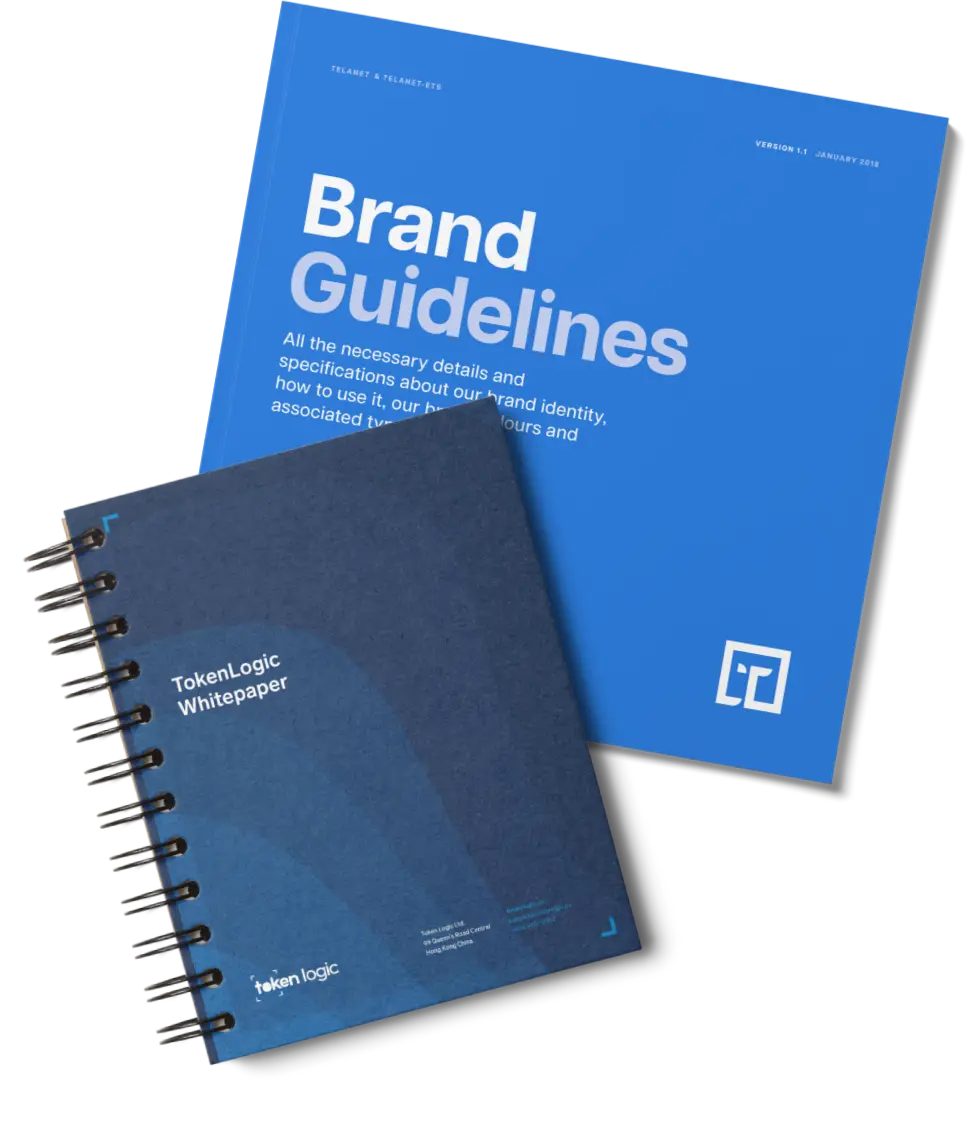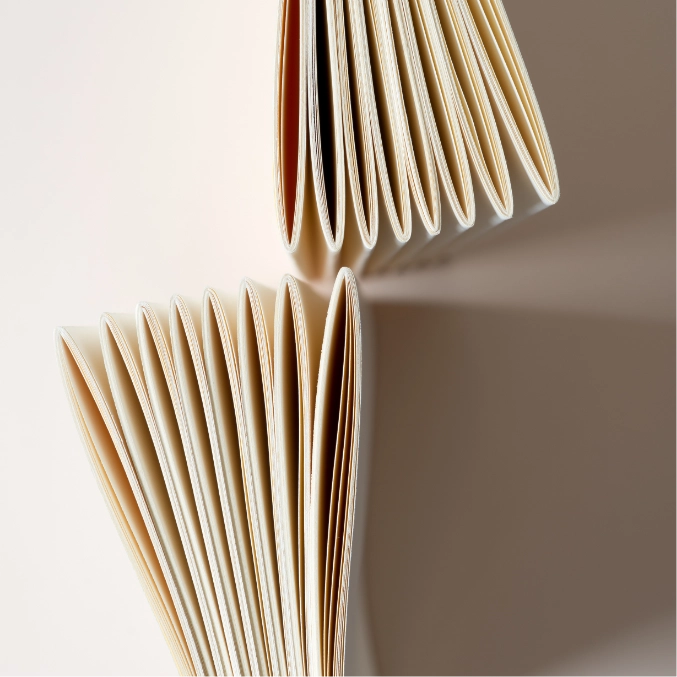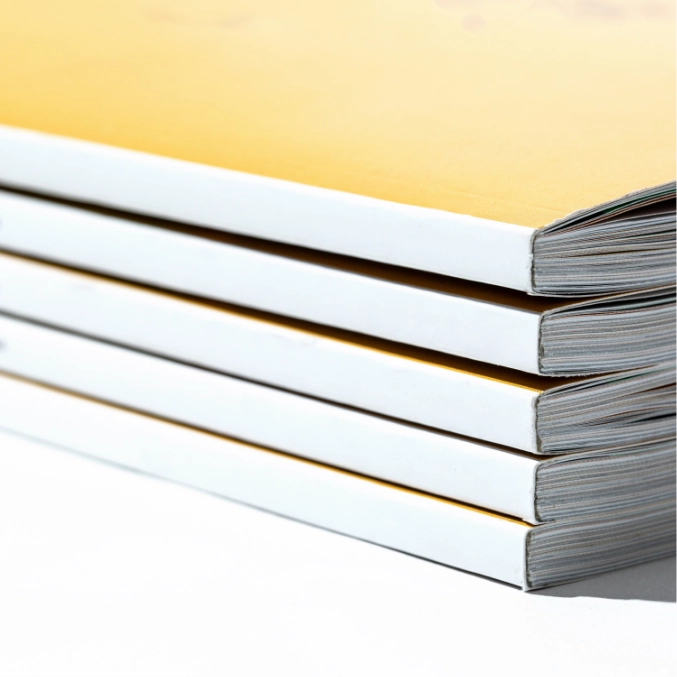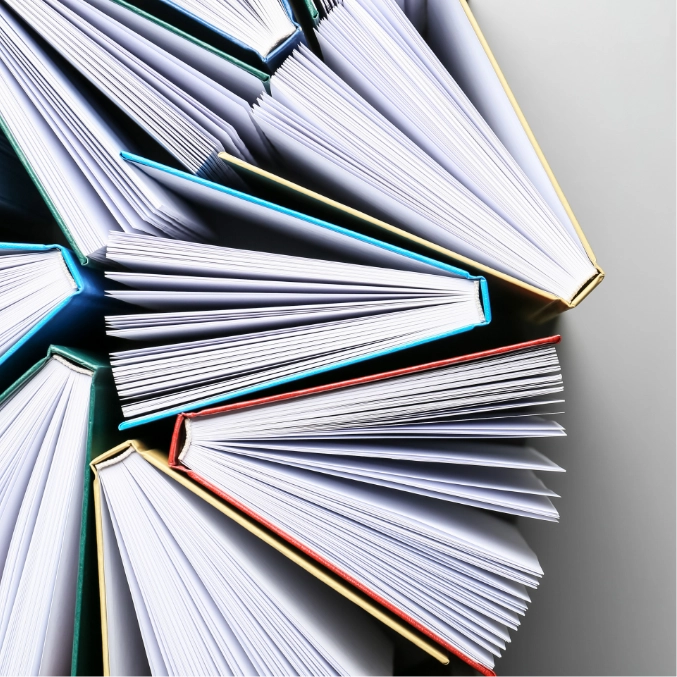Frequently asked questions
Find all your book printing answers here.
And if you don't, reach out to us and we will gladly get back to you.

General
How long does it take?
The estimated time of arrival is always indicated once we process a quotation. The amount of time varies depending on the book style, amount of pages and the number of books being printed.
Why does the unit rate decrease when more books are ordered?
Because of the number of operations involved with the various bindery methods, there are several fixed set-up costs. These costs are the same regardless of the quantity being ordered. When the quantity is higher, the fixed costs are spread out over the increased quantity and therefore the unit rate decreases.
What is the minimum number of copies that I can print?
For multi-page documents, our minimum order quantity is 25 copies, and you can order in increments of 1 copy. Thus, if you want 102 copies, you can order 102 copies. The minimum order quantity for other single page products other than books (brochures, business cards, envelopes, flat sheets, flyers, greeting cards, newsletters, postcards, posters, and rack cards) will be noted in the quotation process.
What if I’m not happy with the quality?
Our experts look at all of the documents that come in. If the file is not up to specification, we advise our customers that there may be print quality issues. We always recommend printing a proof prior to production.
What if I’m not happy with the finished product?
If the proof looked better than the final piece, we will do everything in our power to fix the issue. We strive on printing quality products with amazing customer service!
Shipping / Delivery
Once I approve my proof, how long does it take to print my order?
Your order will print within 3 business days (weekends and holidays are not counted) after proof approval. For an additional charge, we also have 3-day, 2-day, 1-day and same day turnaround. Before ordering with same day service, please check with us to make sure that we have enough time to process your order the same day.
Once my order is shipped, how many days will it take to reach me?
All orders are shipped from our facility in Toronto, Ontario, via your choice of courier. You can also select 3-day, 2-day, and overnight service. You must pay for any expedited service.
product
What size books do you print?
Generally, standard book sizes are 8.5 x 11 inches and 5.5 x 8.5 inches. However, a quote can be requested for books that are custom sizes.
What are the different binding options available?
- Saddle Stitch: This is one of the most economical options and best suited to booklets with lower page counts. This is because the sheets are gathered, folded, and staples on the spine, and in booklets, with more than 60 pages the pages tend to “bubble” at the spine and not lay perfectly flat.
- Perfect Binding: Also know as Soft-Cover binding, this binding method involves glueing the pages together at the spine and wrapping the cover around this “book block”. This is one of the only binding methods that allows for printing on the spine. While most binding methods have a maximum page count, Perfect Binding has a minimum. The book block must be a minimum of .125” thick or else the pages might not glue properly.
- Spiral/Coil Binding: The pages are punched and wound onto a plastic spiral, this allows the pages to open 360 degrees. As the coil comes in a range of size this option is better able to accommodate larger page counts while still being a relatively economical option.
- Wiro Binding: Wiro is similar to spiral binding, except instead of a plastic coil, the binding is formed with double loops of wire. This gives this binding method a more professional appearance than the plastic spiral, while still accommodating larger page counts and allowing the pages to rotate 360 degrees.
- Hard Cover Binding: A hardcover book is a type of bookbinding where the book’s covers are made from a sturdy and rigid material, typically cardboard or chipboard, and covered with a durable material such as cloth, leather, or paper. The covers are attached to the book’s spine, protecting the pages within.
What is the difference between Self Cover and Plus Cover?
The main difference between Self Cover and Plus Cover is the paper that the cover portion is printed on. Plus Cover booklets have the cover portion printed on a different paper than the inside pages, whereas Self Cover booklets have the cover printed on the same paper as the rest of the booklet.
A Plus Cover booklet allows for special finishes and the use of a thicker stock on the cover, however, the cover has to be run separately from the insides. This makes Self Cover the more economical option.
What is the difference between sheets and pages?
The easiest way to think about pages is to think about a PDF document with multiple pages. Each page in that PDF document would be equivalent to one page in the finished, bound book. A sheet is what the pages are printed on. For saddle stitching, a sheet has 4 pages on it, and therefore the page count must be divisible by 4. For Spiral, Wire-O, Perfect Binding, and Corner Stapling, a sheet has 2 pages.
Setup
Do I need to submit a print-ready document?
We recommend sending a print-ready document. What does that mean? The document must contain trim marks, bleed and graphics that are above 300 PPI for optimal print quality.
Do I need to include bleed?
Yes, booklets do require bleed. The standard .125 inch or 1/8 inch bleed will still be required on all edges, including the spine.
Are there special margin requirements for Book Printing?
For saddle stitch booklets, a minimum of .25 inches on all edges would be required. For Spiral, Wir-O, and Perfect Binding, these bindings require additional margin at the spine. For Spiral and Wir-O, an additional .25 inches on the spine is required for the punches. For Perfect Binding, an additional .25 inches is also required, so that no page content ends up too close to the spine.
Which program should be used to design files for Book Printing?
The best program to design books would be Adobe InDesign, as this program was specifically created to design multipage files intended to be bound in some fashion and has several useful features.
What formats do you accept for files?
We highly recommends that you submit your files as PDF files. With PDF files, you can save your files as high resolution files with fonts embedded. The advantage of this file type is that fonts and graphics are embedded in the file, so that the file is almost like a photograph. You don’t have to worry that we won’t have the right font or that fonts and graphics will shift, which often happens when a native file is opened on different computers.
When preparing a PDF file, it is important to ensure that you create a high-resolution file (300 dpi) with fonts embedded. Also, make sure that your PDF file contains bleeds and crop marks and is set to CMYK colour. If you are not sure how to set up a PDF file, see our detailed instructions here.
What is the difference between RGB and CMYK colour formats?
RGB refers to the primary colours of light — red, green, and blue — and is the standard format used for digital cameras, scanners, video monitors, and television screens. CMYK refers to the primary colours used in printing — cyan, magenta, yellow, and black. When you hear the term four-colour process printing or full-colour printing, it is referring to these four colours. RGB files must be converted to CMYK files before printing, since it is physically impossible for a printing press to reproduce RGB colours.
Pantone colours are exact colours that have unique coated or uncoated numbers attributed to them. These colours are rich in nature and used in special printing when wanting to match a specific colour. Often brands will have a unique pantone colour attributed to their logo.
What resolution should be used for graphics and photos?
Graphics and photos should be at least 300 dpi to ensure that they do not look grainy when printed. Just because a photo looks good on your screen, which has 72 dpi resolution, does not mean that it will print well.
How large should the margin be on documents?
Be sure to allow adequate margins all the way around your document, but especially on the bound edge. Perfect binding, wire-o binding, and plastic coil binding will use approximately 1/8 of an inch on the bound edge. You also want to make sure that there is sufficient room on perfect bound books to be easily read without the reader breaking the spine. We recommend at least 3/4 of an inch margin on the bound side.
How do I calculate the spine width for a perfect bound book?
We recommend that you submit covers for perfect bound document as three files — the front cover, the back cover, and the spine. The size of your front and back cover should equal the size of your document plus 1/8 inch bleed on all four sides.
To calculate the size of your spine, use this formula:
For 60# uncoated text, 70# matte and gloss text stock, and 80# matte and gloss text stock:
Number of pages divided by 440 = spine in inches
For 70# uncoated text and 100# matte and gloss text stock:
Number of pages divided by 370 = spine in inches
When counting pages, include the cover. When preparing your spine, be sure to add 1/8 bleed on all four sides. If you are adding text to your spine, make sure that you do not make the size of the text exactly equal to the width of the spine. Leave some blank room on both sides of the text so the text does not run exactly to the edge of the spine.
How do I count pages in my document?
When counting pages for pricing and ordering, count the pages like pages in a book, not sheets of paper. An 8.5 x 11 sheet of paper with printing on both sides is two pages in your document. Our pricing and ordering calculators assume that you are printing on both sides of the sheet of paper.
Alternative Types of Book Printing

Saddle Stitch Book
Turn your report into a saddle stitch book.
Saddle stitch is the most popular and cost-effective binding method for small booklets.

Perfect Bound Book
The perfect high-end feel to your corporate catalogue.
